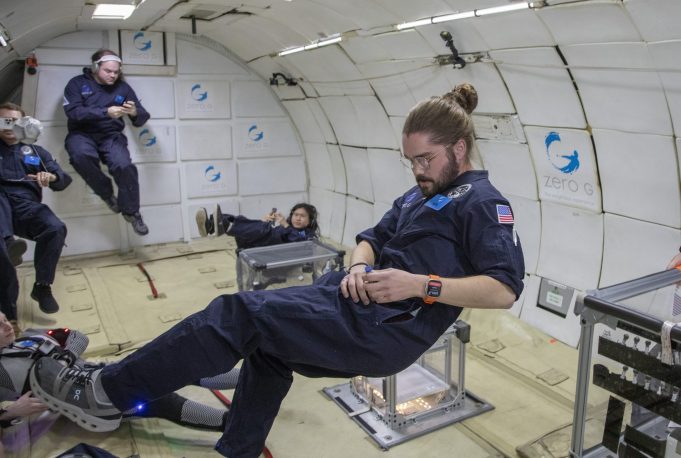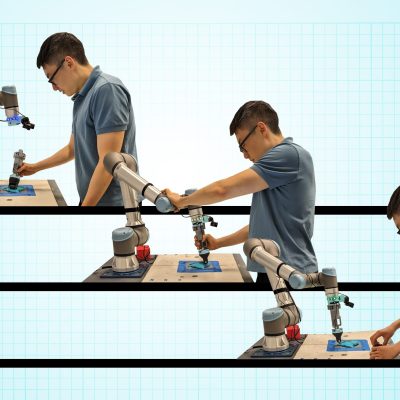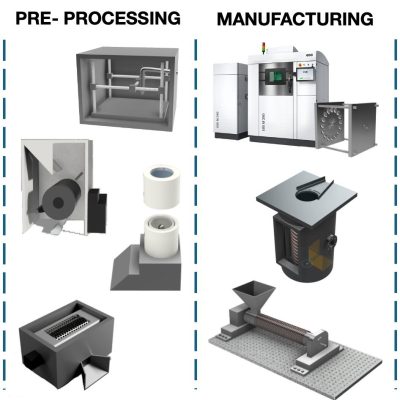AeroAstro soars in zero gravity
This May, numerous members of the AeroAstro community flew on parabolic flights, bringing research and representation to zero gravity.
On May 14, six AeroAstro researchers flew as part of the MIT Space Exploration Initiative’s zero gravity flight cohort, flying research experiments designed for microgravity. The Space Exploration Initiative (SEI) has been running microgravity research flights regularly since 2017. Students and researchers who wish to run an experiment on a parabolic flight apply for a course that guides them through the process of developing a project for zero gravity, co-taught by instructors from the Media Lab and AeroAstro.
Also on board the flight were Dava Newman, Apollo Program Professor of Aeronautics and Astronautics and Director of the MIT Media Lab; Lonnie Petersen, Charles Stark Draper Professor and Assistant Professor of Aeronautics and Astronautics; and Cody Paige, AeroAstro alum (PhD ‘24) and Director of the Space Exploration Initiative.
And on May 17, Cadence Payne flew as part of Aurelia Institute’s Horizon Zero Gravity Flight program, in her capacity as a Matthew Isakowitz Fellow.
Learn more about the AeroAstro fliers and their projects:
Charles Dawson
PhD student, REALM Lab
Project: Getting a grip in microgravity (free-floating robot manipulation)
This project aims to develop and test a robotic platform for manipulating objects in microgravity, demonstrating 100% onboard perception, planning, and control for reactive manipulation of floating objects. The ultimate goal of this project is to develop robust autonomy for automating logistics and manufacturing tasks in space.
Amelia Gagnon
PhD student, STAR Lab and MathWorks Fellow
Project: Examining the use of fNIRS in an acute microgravity environment for mental workload observation
The goal of this experiment is to gather fNIRS and physiological instrumentation observations of a participant performing a task while on the ZeroG plane and statistically compare the observations to those of the same participant performing the same task but in Earth gravity. To elicit increased mental workload, participants will perform a memory task on an iPad app. In this task, called an n-back test, participants are asked to hold several items for memory and think back to an earlier item. While these items can be letters, numbers, colors, or sounds, the app designed for this experiment is entirely visually-based to account for the noisy environment of the aircraft cabin. Over the course of the parabola, the participant is shown different shape colors and locations at a constant rate. When prompted, the participants must recall an earlier color or location of the shape.
Kyle Horn
PhD student, Human Systems Lab and AstroAccess Ambassador
Project: Qualifying Insulin Pumps for Spaceflight (QuIPS)
The mission of this project is to demonstrate the safety and efficacy of insulin delivery pumps in micro- and hyper-gravity to advance the accessibility of human spaceflight for the disabled community. This work will not only carve a path to space for people living with diabetes, but also provide the first comprehensive understanding of the physical limitations of insulin pump technology in extreme environments.
Madelyn Hoying
PhD student, Harvard-MIT Program in Health Sciences and Technology
Project: Microgravity fluid behavior for medical device design
This project looks at fluid behavior in altered gravity conditions to inform medical device design. Results will let us develop devices to monitor epithelial barrier function in astronauts on the Moon, Mars, and in microgravity.
Fabian Moeller
Postdoctoral associate, Aerospace Physiology Lab
Project: Wearable lower-body negative pressure
This project tests the feasibility of a novel wearable lower-body negative pressure (LBNP) suit in partial gravity and weightlessness and quantifies resulting cardiovascular responses and ground reaction forces. In general, countermeasures are integral to all sojourns in reduced gravity to diminish the risks induced by adaptations of the physiological system. These risks include spaceflight-associated neuro-ocular syndrome (SANS) in flight, orthostatic intolerance (OI) after the transition to Earth or partial gravity in future planetary landings, and deterioration of the cardiovascular and musculoskeletal systems. Long-term cranial fluid shift, as the primary cause for the prevalence of SANS and OI, can be temporarily reversed by applying LBNP. The novel suit design combines these effects with cardiovascular and musculoskeletal benefits by generating mechanical load on muscle and bones from ground-reaction forces and increasing operational feasibility during mission-related tasks. This work is a step toward quantifying the optimum dosage and duration for LBNP protocols to advance it as a countermeasure for deep space exploration.
Golda Nguyen
PhD student, Human Systems Lab
Golda joined the fight to participate in Amelia Gagnon’s research project, “Examining the use of fNIRS in an acute microgravity environment for mental workload observation.”
Cadence Payne
PhD student, STAR Lab and Matthew Isakowitz Fellow
On the Aurelia Horizon flight, Cadence assisted fellow flier Nathalie Vilchis Lagunes, a Brooke Owens Fellow, with her project, AVRO (Aerospace Vine Robot Operation). This experiment aims to analyze the Vine robot’s behavior, limitations, and potential to hold and move objects around in a microgravity environment. Cadence represented the Matthew Isakowitz Fellowship program on the flight, and she also flew in her MIT graduation robes, celebrating her upcoming PhD hooding.
Jess Todd
PhD student, Human Systems Lab
Jess joined the flight to help other researchers with their projects, including Madelyn Hoying, Cody Paige, and Media Lab researcher Fangzheng Liu.







